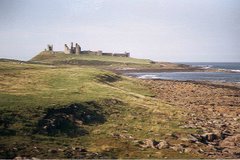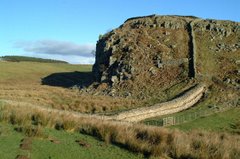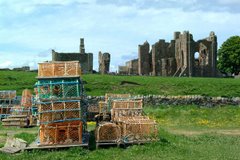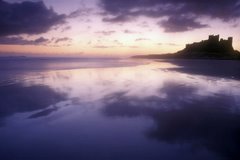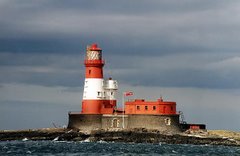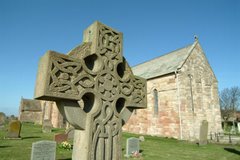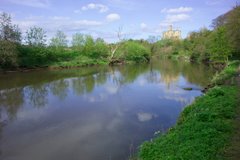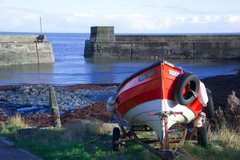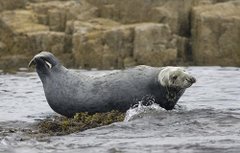Lindisfarne (Holy Island)
The island is a tourist hot spot because of its rich Christian heritage and stunning natural landscape. The monastery of Lindisfarne was founded by Irish born Saint Aidan, who had been sent from Iona off the west coast of Scotland to Northumbria at the request of King Oswald around AD 635. It became the base for Christian evangelising in the North of England and also sent a successful mission to Mercia. Monks from the community of Iona settled on the island. Northumberland's patron saint, Saint Cuthbert, was a monk and later Abbot of the monastery, and his miracles and life are recorded by the Venerable Bede. Cuthbert later became Bishop of Lindisfarne. At some point in the early 700s the famous illuminated manuscript known as the Lindisfarne Gospels, an illustrated Latin copy of the Gospels of Mark, Luke, Matthew and John, was probably made at Lindisfarne. Sometime in the second half of the tenth century a monk named Aldfrith added an Anglo-Saxon (Old English) gloss to the Latin text, producing the earliest surviving Old English copies of the Gospels. The Gospels were illustrated in an insular style containing a fusion of Celtic, Germanic and Roman elements; they were probably originally covered with a fine metal case made by a hermit called Billfrith.
Eventually the monks fled the island (taking with them the body of St Cuthbert, which is now buried at the Cathedral in Durham). The bishopric was transferred to Durham in AD 1000. The Lindisfarne Gospels now reside in the British Library in London, somewhat to the annoyance of some Northumbrians. The priory was re-established in Norman times as a Benedictine house and continued until its suppression in 1536 under Henry VIII. It is now a ruin in the care of English Heritage, who also run a museum/visitor centre nearby. The neighbouring parish church (see below) is still in use.
Lindisfarne also has the small Lindisfarne Castle, based on a Tudor fort, which was refurbished in the Arts and Crafts style by Sir Edwin Lutyens (who also designed the island's Celtic-cross war-memorial on the Heugh) and has a garden created by Gertrude Jekyll. The castle, garden and nearby limekilns are in the care of the National Trust and open to visitors.
Lindisfarne had a large lime burning industry and the kilns are among the most complex in Northumberland. There are still some traces of the jetties by which the coal was imported and the lime exported close by at the foot of the crags. Lime was quarried on the Island and the remains of the wagon way between the quarries and the kilns makes for a pleasant and easy walk. This quarrying flourished in the mid-19th century during the Industrial Revolution when over 100 men were thus employed.
Lindisfarne was mainly a fishing community for many years, with farming and the production of lime also of some importance. Tourism grew steadily throughout the twentieth century, and it is now a popular place with visitors — sometimes a little too popular, as space and facilities are limited. By staying on the island while the tide cuts it off (time permitting) the non-resident visitor can experience the island in a much quieter mood, as most day visitors leave when the tide is rising again. It is possible, weather and tide permitting, to walk at low tide across the sands following the older crossing line known as the Pilgrims' Way and marked with posts: it also has refuge boxes for the careless walker, in the same way as the road has a refuge box for those who have left their crossing too late.
The Holy Island of Lindisfarne is well known for mead. In the medieval days when the monks inhabited the island, it was thought that if the soul was in God's keeping, the body must be fortified with this elixir of herbs and honey, the wine bequeathed to posterity as Lindisfarne Mead. The monks have long vanished, but their spirit lingers in this aphrodisiac whose exact recipe remains a secret of the family still producing it. Lindisfarne mead is produced at St Aidan's Winery, and sold throughout the UK and elsewhere.
Article adapted from the Wikipedia online encyclopedia.
How to get to Holy Island:
By road: Holy Island is conveniently located just off the main A1 road. It is about 10 miles south of Berwick upon Tweed.
By rail: The nearest station is Berwick upon Tweed. The station is on the main east coast railway line and is served frequently by trains from London and Newcastle upon Tyne in the south and Edinburgh in the north.
By bus: Arriva Northumbria services 501 and 505 (525 on Sundays and Bank Holidays) run from Newcastle upon Tyne and Berwick upon Tweed past Beal road end (the road leading to the island).
Map of area: CLICK HERE


